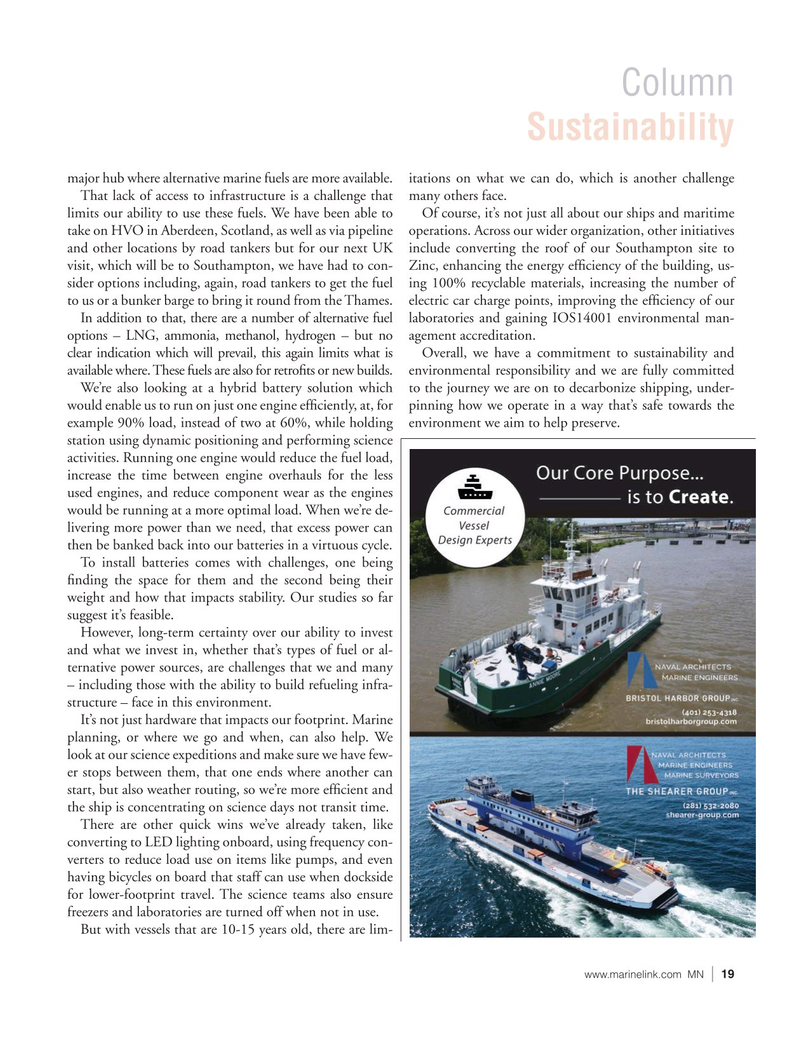
Page 19: of Marine News Magazine (October 2024)
Read this page in Pdf, Flash or Html5 edition of October 2024 Marine News Magazine
Column
Sustainability major hub where alternative marine fuels are more available. itations on what we can do, which is another challenge
That lack of access to infrastructure is a challenge that many others face. limits our ability to use these fuels. We have been able to Of course, it’s not just all about our ships and maritime take on HVO in Aberdeen, Scotland, as well as via pipeline operations. Across our wider organization, other initiatives and other locations by road tankers but for our next UK include converting the roof of our Southampton site to visit, which will be to Southampton, we have had to con- Zinc, enhancing the energy ef? ciency of the building, us- sider options including, again, road tankers to get the fuel ing 100% recyclable materials, increasing the number of to us or a bunker barge to bring it round from the Thames. electric car charge points, improving the ef? ciency of our
In addition to that, there are a number of alternative fuel laboratories and gaining IOS14001 environmental man- options – LNG, ammonia, methanol, hydrogen – but no agement accreditation. clear indication which will prevail, this again limits what is Overall, we have a commitment to sustainability and available where. These fuels are also for retro? ts or new builds. environmental responsibility and we are fully committed
We’re also looking at a hybrid battery solution which to the journey we are on to decarbonize shipping, under- would enable us to run on just one engine ef? ciently, at, for pinning how we operate in a way that’s safe towards the example 90% load, instead of two at 60%, while holding environment we aim to help preserve. station using dynamic positioning and performing science activities. Running one engine would reduce the fuel load, increase the time between engine overhauls for the less used engines, and reduce component wear as the engines would be running at a more optimal load. When we’re de- livering more power than we need, that excess power can then be banked back into our batteries in a virtuous cycle.
To install batteries comes with challenges, one being ? nding the space for them and the second being their weight and how that impacts stability. Our studies so far suggest it’s feasible.
However, long-term certainty over our ability to invest and what we invest in, whether that’s types of fuel or al- ternative power sources, are challenges that we and many – including those with the ability to build refueling infra- structure – face in this environment.
It’s not just hardware that impacts our footprint. Marine planning, or where we go and when, can also help. We look at our science expeditions and make sure we have few- er stops between them, that one ends where another can start, but also weather routing, so we’re more ef? cient and the ship is concentrating on science days not transit time.
There are other quick wins we’ve already taken, like converting to LED lighting onboard, using frequency con- verters to reduce load use on items like pumps, and even having bicycles on board that staff can use when dockside for lower-footprint travel. The science teams also ensure freezers and laboratories are turned off when not in use.
But with vessels that are 10-15 years old, there are lim- www.marinelink.com MN 19|

 18
18

 20
20
